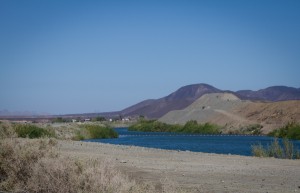The long awaited “Moving Forward Phase 1” report on opportunities for managing water in the Colorado River Basin plopped into public view this afternoon.
I’m going to use the prerogative of a journalist no longer beholden to daily deadlines to wait until I’ve actually had time to review and think about the 448 page report about before writing about it. (Ah, the luxury.)
My quick reaction after a quick trip through the executive summary (and with a knowledge of how long it took to get the report out the door – the release was originally planned for December) is that it’s as interesting for what it doesn’t recommend as for what it does. By that I mean that actually solving the basin’s problems will require more than a report with a list of recommendations that we can all charge out and implement. You’re not going to see an “X million acre feet out of municipal use by taking the following steps, and Y million acre feet out of ag.” Those numbers must emerge from difficult tradeoffs and negotiations and institutional evolution over time, a process of innovation and experimentation. In that regard, the most interesting comment in the flurry of news releases that hit my inbox this afternoon came from David Festa at the Environmental Defense Fund: “With so many interests coming together with a shared sense of responsibility and opportunity, we can indeed move forward. We don’t have time to lose. Securing new funding sources and implementing pilot projects are key next steps.” In other words, this is about process. We have to do some stuff in order to learn how to do more stuff.
It’s worth sharing in the meantime comments from a group of prominent Colorado River Basin scholars who have had the time to review it. They argue in a new white paper also out today that we have a “window of opportunity” opening to shift the dialogue over the overtaxed river from “resource management” to “use management”.
The release of the new paper from the Colorado River Research Group coincides with the U.S. Bureau of Reclamation’s “Moving Forward” report, the followup to its 2012 Colorado River Basin Supply and Demand Study.
Here’s the meat of the new CRRG white paper:
The challenges facing the Colorado River Basin are varied and significant. In particular, population growth, drought, and climate change all are likely to further strain the regional water budget unless our management of water uses evolves to match our expertise in managing water resources. Fortunately, there’s also no shortage of viable, cost-effective solutions, and the many reforms enacted during the past decade have opened a short window of opportunity for basin residents to consider what a lasting solution might look like. It’s clear that any real solution must take advantage of the many inefficient water uses that persist throughout the basin, which are every bit as much of an opportunity to embrace as a problem to lament.
It looks to me like the CRRG folks don’t think the new Bureau report goes far enough – focusing on quantifying past municipal conservation successes, for example, without quantifying expectations of future progress. Again, from the white paper, discussing the work of the municipal conservation work group:
To date, that workgroup has focused on documenting the effectiveness of past and planned conservation efforts in the major metropolitan areas serving over 29 million residents—more than 85 percent of all municipal water users served by the Colorado. Preliminary findings suggest conservation and re-use programs active since 1990 have reduced 2010 M&I demand levels by nearly 2.4 million acre-feet/year.
On the downside, this level of water demand savings was sufficient only in “partially attenuating the effect of population growth on M&I water use.” And in the next two decades (2010 to 2030), the workgroup suggests a much more tempered estimate of potential savings: roughly 700,000 acre-feet/year. While it’s true that conservation can become increasingly difficult as the most egregious wastes of water are eliminated first, we suspect that this modest savings projection—just like previous M&I demand estimates in the basin—is heavily influenced by the risk-aversive nature of water providers who understand it’s much safer for them to over-estimate (than under-estimate) demand.
But my inbox also is full of enthusiasm for the Moving Forward report, in the form of press release quotes:
John Entsminger, Southern Nevada Water Authority
There is a shared risk and shared responsibility among all water users associated with proactively managing the water supply and demand imbalance. Municipal and agricultural conservation and reuse have been used successfully in the past across multiple use sectors and are key elements in resource plans that will undoubtedly be critical programs in the future to provide sustainability of the river and its many resources.
Tina Shields at the Imperial Irrigation District:
There are opportunities to do more in all sectors to enhance western agriculture, environmental values and provide flexibility for growing water needs through voluntary incentive-based efficiency and conservation programs.
Jim Lochhead, Denver Water
Continuing drought conditions in the Colorado River basin, combined with the California drought, are a sobering reminder that the time for action is now. Doing nothing is not an option. Throughout the basin, and across all water sectors, we face a challenge to step up and lead. We can take control of our destiny, or we can allow drought and climate change to overwhelm us.
The Bureau’s Terry Fulp:
The impacts of the ongoing drought are widespread and are currently being addressed at the local and regional levels. Looking ahead to the longer-term challenges facing the Basin documented in the 2012 Study, it is clear that these challenges must be tackled collaboratively involving all sectors of use. The Phase 1 Report is a critical first step towards this level of collaboration.


Pingback: Bloggers Continue to Address California Drought, Also Cover San Juan Capistrano Court Decision and Management in the Colorado River Basin